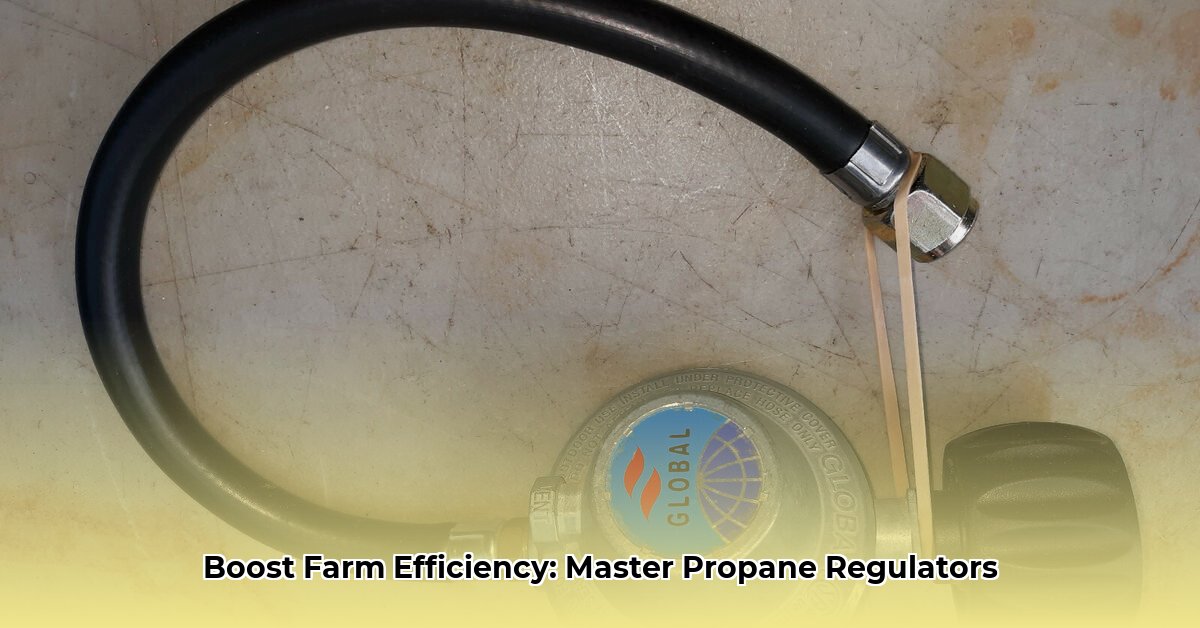
Farming demands reliable equipment, and reliable equipment needs fuel. Propane offers a cleaner, more efficient alternative to diesel for various farm applications, but maximizing its benefits hinges on understanding your propane regulator. This guide provides actionable steps to select, install, and maintain the right propane regulator from Tractor Supply, enhancing your farm's efficiency and sustainability. For more information on propane tanks, check out these Tractor Supply propane tanks.
Understanding Propane Pressure Regulators: The Heart of Your Propane System
A propane regulator is the crucial component controlling propane flow from your tank to your equipment. It reduces the high-pressure gas from the tank to a usable pressure for your appliances, such as irrigation pumps, heaters, or grills. Without a properly functioning regulator, your equipment may underperform or even suffer damage from excessive pressure. Think of it as the gatekeeper, ensuring a safe and consistent propane supply. Consistent pressure directly impacts equipment longevity and operational efficiency. Different regulators are designed for various applications and pressure requirements, meaning selecting the correct regulator is critical for optimal performance.
Selecting the Right Propane Regulator for Your Farm: A Practical Guide
Choosing the right propane regulator from Tractor Supply requires careful consideration of several key factors:
1. Input Pressure: This refers to the pressure at the regulator's inlet, typically the high pressure from your propane tank. It's crucial this matches your tank's output pressure for safe and efficient operation. A mismatch can lead to system malfunction.
2. Output Pressure: This specifies the pressure at the regulator's outlet, the lower, controlled pressure needed by your equipment. Always consult your equipment's manual for the exact required pressure.
3. Flow Rate: This indicates the regulator's capacity to handle propane flow per hour. The flow rate should comfortably exceed your equipment's typical propane consumption. An undersized regulator can lead to insufficient fuel supply.
4. Regulator Type: There are three main types: single-stage, two-stage, and vaporizers. Single-stage regulators are simpler and less expensive, but two-stage regulators offer more consistent pressure, preventing fluctuations that might damage equipment. Vaporizers convert liquid propane to gas, useful in cold climates.
Here's a summary table for quick reference:
| Feature | Description | Considerations |
|---|---|---|
| Input Pressure | Pressure at the regulator's inlet (from the tank) | Must match your propane tank's output pressure precisely. |
| Output Pressure | Pressure at the regulator's outlet (for equipment) | Match your equipment's specific pressure requirements (check your equipment's manual). |
| Flow Rate | Propane handling capacity (e.g., cubic feet per hour) | Choose a flow rate exceeding your equipment's typical propane consumption. |
| Type | Single-stage, two-stage, or vaporizer | Select the type best suited for your equipment's pressure needs and climatic conditions. |
Installing Your Propane Regulator: A Step-by-Step Process
Correct installation is paramount for both safety and efficient operation. Always adhere to the manufacturer's instructions included with your specific regulator. Here’s a general guideline:
Step 1: Prioritize Safety: Turn off your propane tank valve completely before starting any installation or maintenance procedures.
Step 2: Connecting the Regulator: Securely attach the regulator to both the tank and your equipment, ensuring all connections are tight but not over-tightened. Use the correct size wrench to avoid damaging the connections.
Step 3: Critical Leak Check: Thoroughly inspect all connections for leaks using a commercially available leak detection solution. This is a crucial safety measure to prevent gas leaks.
Step 4: Activation: Once you've confirmed leak-free connections, slowly open the tank valve.
Step 5: Performance Monitoring: Carefully start your equipment and monitor its performance and the regulator's operation closely.
Maintaining Your Propane System: Long-Term Strategies for Efficiency
Regular maintenance is vital for safety and optimal system performance.
Regular Inspections: Conduct periodic inspections of your entire propane system, examining for any signs of damage, corrosion, or leaks.
Cleanliness: Keep all connections clean and free from debris to prevent blockages and maintain proper sealing.
Pressure Monitoring: Use a pressure gauge to periodically check the output pressure, maintaining it within the recommended range for your equipment.
Professional Maintenance: Schedule annual inspections by a qualified propane technician to ensure everything operates safely and efficiently. This helps catch and prevent issues before they become significant problems.
Investing in a quality propane regulator from Tractor Supply is an investment in farm efficiency and safety. By following these guidelines for selection, installation, and maintenance, you'll ensure long-lasting, reliable performance of your propane equipment. The small effort spent on proper maintenance will yield significant returns in reduced downtime and improved productivity.